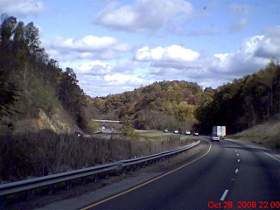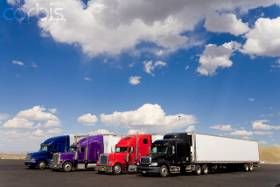Where To Set The Tandems ?
Topic 2294 | Page 1

Basically the safest thing to do is set it for the California 40' mark. That will get you close as possible to legal till you can weight out. Now this will not guarantee you will be legal and you can still get a ticket if over weight on any axles but its close if the truck is loaded correctly in the first place.
Some trucks have a gauge on the dashboard that shows how much pressure is on the drive axles. Learn the gauge, learn where 34,000 pounds is on the gauge.
The meter in the gauge doesn't show it in weight, it shows it in psi. On my gauge 60 equals 34,000 pounds. So if its on the 60 psi I know that the weight on my drive axles is 34,000.
Having said that, when I get done with a pickup I slide my tandems giving as much weight to the drives as possible. If I know that it's a load I can carry legally, then putting the majority of the weight on the drives usually ensures me that I'm legal.
Obviously, if my load is only in the 30's then I don't need to give all the weight to the drives. I just set it at the 40' mark usually and weigh it out. But if I'm on a heavy load, I max out my drives to ensure that I'm legal until I get to a cat scale. Then I fix it.
Hope that makes sense.
Tandems:
Tandem Axles
A set of axles spaced close together, legally defined as more than 40 and less than 96 inches apart by the USDOT. Drivers tend to refer to the tandem axles on their trailer as just "tandems". You might hear a driver say, "I'm 400 pounds overweight on my tandems", referring to his trailer tandems, not his tractor tandems. Tractor tandems are generally just referred to as "drives" which is short for "drive axles".
Tandem:
Tandem Axles
A set of axles spaced close together, legally defined as more than 40 and less than 96 inches apart by the USDOT. Drivers tend to refer to the tandem axles on their trailer as just "tandems". You might hear a driver say, "I'm 400 pounds overweight on my tandems", referring to his trailer tandems, not his tractor tandems. Tractor tandems are generally just referred to as "drives" which is short for "drive axles".
CAT Scale:
A network of over 1,500 certified truck scales across the U.S. and Canada found primarily at truck stops. CAT scales are by far the most trustworthy scales out there.
In fact, CAT Scale offers an unconditional Guarantee:
“If you get an overweight fine from the state after our scale showed your legal, we will immediately check our scale. If our scale is wrong, we will reimburse you for the fine. If our scale is correct, a representative of CAT Scale Company will appear in court with the driver as a witness”

Sorry guys, I'm not sure what you mean by the 40" inch mark ? On the trailer we have ABCD markings with the notches in between. Clearly my trainer has failed me. Am I to understand that I could still get a fine if I'm under 80k and my weight isn't properly distributed ?
Some states are picky and want your trailer tandems to be at a specific distance from your kingpin.
CA requires 40' distance between the kingpin and the center of the rear trailer axle. If the distance from the center of the rear axle and the kingpin is 41' then you are illegal to drive in CA and will be ticketed.
We both say 40' because that's usually a safe place to put the trailer tandems, assuming the shipper didnt load the trailer in a stupid way.
All of this and much more is covered in our The High Road CDL Training Program. Study the Weight & Balance section. Seriously, study it. You're only hurting yourself if you don't. Plus it's totally free!
You need to know these things in order to survive on the road. It's critical.
CDL:
Commercial Driver's License (CDL)
A CDL is required to drive any of the following vehicles:
- Any combination of vehicles with a gross combined weight rating (GCWR) of 26,001 or more pounds, providing the gross vehicle weight rating (GVWR) of the vehicle being towed is in excess of 10,000 pounds.
- Any single vehicle with a GVWR of 26,001 or more pounds, or any such vehicle towing another not in excess of 10,000 pounds.
- Any vehicle, regardless of size, designed to transport 16 or more persons, including the driver.
- Any vehicle required by federal regulations to be placarded while transporting hazardous materials.
Shipper:
The customer who is shipping the freight. This is where the driver will pick up a load and then deliver it to the receiver or consignee.
Tandems:
Tandem Axles
A set of axles spaced close together, legally defined as more than 40 and less than 96 inches apart by the USDOT. Drivers tend to refer to the tandem axles on their trailer as just "tandems". You might hear a driver say, "I'm 400 pounds overweight on my tandems", referring to his trailer tandems, not his tractor tandems. Tractor tandems are generally just referred to as "drives" which is short for "drive axles".
Tandem:
Tandem Axles
A set of axles spaced close together, legally defined as more than 40 and less than 96 inches apart by the USDOT. Drivers tend to refer to the tandem axles on their trailer as just "tandems". You might hear a driver say, "I'm 400 pounds overweight on my tandems", referring to his trailer tandems, not his tractor tandems. Tractor tandems are generally just referred to as "drives" which is short for "drive axles".
The system another driver taught has worked well for me except in instances where they load you wrong:/ In this method you count the first whole, skip the second and then cout 2,3,4,5 ect. Under 20000 8th hole, 20000-30000 7th hole 30000-40000 6th hole and 40000+ 5th hole. If you know your air gauge it should act as a guide to know if these weights are right. Like I said been using it for awhile and its almost always on point.
Bonaro the letters are on the side referring to the king pin distance. A is Ca. only and 40'. What truck you got? The freightliners have the gauge Daniel talks about and 60 is 33800 on them. If your in a International hit your button on the dash. Cycle it through till you get to a lbs reading. It's just before it goes back to the mileage. We usually set between B & C for most loads and are legal except Ca. Give me a call if you need anything.

I just finished trng, they taught us to put tandems under load as close as you can "measure" from rear door ? 3rd - 4th- 5th row of rivets that correspond to exterior vertically if that makes sense. As explained to us, you have made your best estimate to put the 34k or less on the tandems just like the weight that is directly over the drive tires. To summarize front weight over front tires rear tandems under rear end of load?? .
Tandems:
Tandem Axles
A set of axles spaced close together, legally defined as more than 40 and less than 96 inches apart by the USDOT. Drivers tend to refer to the tandem axles on their trailer as just "tandems". You might hear a driver say, "I'm 400 pounds overweight on my tandems", referring to his trailer tandems, not his tractor tandems. Tractor tandems are generally just referred to as "drives" which is short for "drive axles".
Tandem:
Tandem Axles
A set of axles spaced close together, legally defined as more than 40 and less than 96 inches apart by the USDOT. Drivers tend to refer to the tandem axles on their trailer as just "tandems". You might hear a driver say, "I'm 400 pounds overweight on my tandems", referring to his trailer tandems, not his tractor tandems. Tractor tandems are generally just referred to as "drives" which is short for "drive axles".

I was taught to estimate this way: If trailer is loaded to back doors with 36,000 plus, slide them about 2/3 of the way toward the tractor until you can scale it. If the trailer is not loaded to the back doors and still heavy, take it even further towards the tractor. In other words, slide the tandems toward the heavy. I do not go to California (yet), but this has not failed me and when I do scale I am really close or dead on every time.
Tandems:
Tandem Axles
A set of axles spaced close together, legally defined as more than 40 and less than 96 inches apart by the USDOT. Drivers tend to refer to the tandem axles on their trailer as just "tandems". You might hear a driver say, "I'm 400 pounds overweight on my tandems", referring to his trailer tandems, not his tractor tandems. Tractor tandems are generally just referred to as "drives" which is short for "drive axles".
Tandem:
Tandem Axles
A set of axles spaced close together, legally defined as more than 40 and less than 96 inches apart by the USDOT. Drivers tend to refer to the tandem axles on their trailer as just "tandems". You might hear a driver say, "I'm 400 pounds overweight on my tandems", referring to his trailer tandems, not his tractor tandems. Tractor tandems are generally just referred to as "drives" which is short for "drive axles".

Okay, I'm slowly figuring this thing out. I'm also questioning the money I spent on my schooling since they didn't go over this at all. All they mentioned was the holes and what direction to move them. Anyway, my manual showed me how to access the air suspension display but how am I suppose to know what the numbers mean ? I'm assuming the higher the psi the more weight on my drives. How do I know when I'm over ? I'm in a Volvo if that helps.
New Reply:
New! Check out our help videos for a better understanding of our forum features

















Preview:
This topic has the following tags:
Driver Responsibilities Safe Driving Tips







 TT On Facebook
TT On Facebook
I'm totally new to the job and I was wondering if there were some kind of formula to go by as to where the tandems should be placed based on the weight until a guy has time to get on a scale ?
Tandems:
Tandem Axles
A set of axles spaced close together, legally defined as more than 40 and less than 96 inches apart by the USDOT. Drivers tend to refer to the tandem axles on their trailer as just "tandems". You might hear a driver say, "I'm 400 pounds overweight on my tandems", referring to his trailer tandems, not his tractor tandems. Tractor tandems are generally just referred to as "drives" which is short for "drive axles".
Tandem:
Tandem Axles
A set of axles spaced close together, legally defined as more than 40 and less than 96 inches apart by the USDOT. Drivers tend to refer to the tandem axles on their trailer as just "tandems". You might hear a driver say, "I'm 400 pounds overweight on my tandems", referring to his trailer tandems, not his tractor tandems. Tractor tandems are generally just referred to as "drives" which is short for "drive axles".